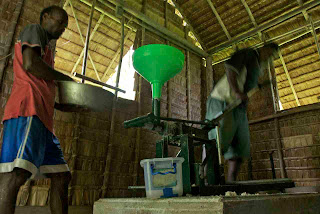
This species is soon to NOT BE anymore if no one does anything about it!
The Beche the Mer comprehends many species of sea cucumbers, elongated urchin type of creatures which filter feed on the sandy bottom of the lagoon. Most of them only come out at night. They are instrumental to reef health as they prevent the overgrowth of algal mats and recycle nutrients.

I was shocked when local driver Morgan, who works for UQ said that is seriously intended to harvest Beche de Mer whilst on duty for the University of Queensland conservation DVD project that I am working on!
The illustration that the cash economy is pressuring everyone. Beche de Mer harvesting has been a major source of income for most Solomon islanders until the population got wiped out and the fishery officially closed by the Ministry throughout the country. It will take years for Beche de Mer to recover but the coconut wireless gossip is that the fishery is re opening soon, so many are already harvesting again in Morovo lagoon, in anticipation!!!!
With no one to enforce the laws, the only solution is to convince the communities to self regulation and that conservating the resource is for their own good. Unfortunately, some Malaysian loggers are still managing to export the Beche de Mer uncontrolled and with possible black market selling outlets, the islanders continue poaching in the lagoon. Asians pay a lot of money for this delicacy. The results are as destructive as the shark fishery but because the poor old seacucumber is not as charismatic as the larger vertebrates, it does not get much media attention.

A few torches were seen at night in the area where we went to film the spawning, their weren’t innocent. The harvest consists of picking the sea slug from the sea bottom at night time. It is the easiest when they all gather at the top of coral heads to spawn. Then the poor seaslug is boiled for 12 hours (a solomon wife’s job!) then dried over a stick rack above a fire for two days. People camp on the outer islands for several days during the harvest. The harvest is so doubly destructive as locals burn a lot of timber to do the drying. Most importantly, locals pick the spawning time, during which masses of Beche de Mer gather on the top of corals to spawn simultaneously, letting the species little chance to reproduce.

This Beche de Mer is spawning - would you believe they can stand up ? But it is lonely on its coral head...Normally, many individual gathers on the same coral heads to maximize chances of fecundation but there aren't enough of them anymore.

Meanwhile, in the deep of the night, the parrot fishes are sleeping in their transparent sleeping pouch, eyes wide open!




































